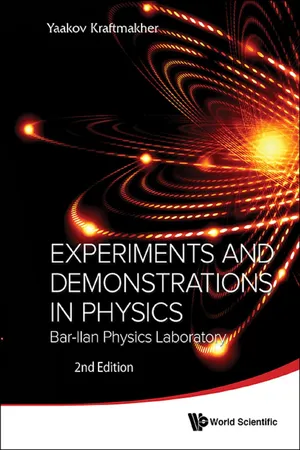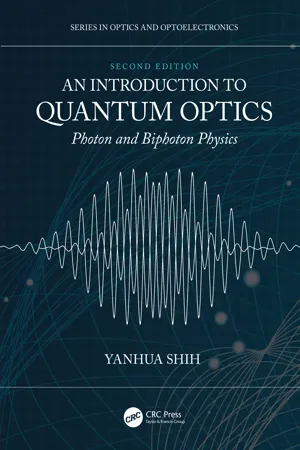Physics
Franck Hertz Experiment
The Franck-Hertz experiment is a fundamental physics experiment that demonstrates the quantization of energy levels in atoms. It involves bombarding a vapor of atoms with electrons and measuring the energy distribution of the electrons that pass through. The experiment provides evidence for the existence of discrete energy levels in atoms, supporting the development of quantum mechanics.
Written by Perlego with AI-assistance
Related key terms
Related key terms
1 of 4
Related key terms
1 of 3
3 Key excerpts on "Franck Hertz Experiment"
- eBook - ePub
Experiments and Demonstrations in Physics
Bar-Ilan Physics Laboratory
- Yaakov Kraftmakher(Author)
- 2014(Publication Date)
- WSPC(Publisher)
“…Professor Franck. Professor Hertz. Through clear thinking and painstaking experimental work in a field which is continuously being flooded by different hypotheses, you have provided a firm footing for future research.”C. W. Oseen, member of the Nobel Committee for Physics. Presentation of James Franck and Gustav Hertz awarded “for their discovery of the laws governing the impact of an electron upon an atom” (1925).Additional equipment: two Voltage sensors, DSO, Franck–Hertz’s tube from PHYWE, DC supply, DC amplifier, capacitor, resistors, switch, 1.5 V battery.In 1914, James Franck and Gustav Hertz reported on an experimental work concerning collisions between electrons and mercury atoms. A hot cathode emits electrons, which are accelerated by a potential applied to a grid (Fig. 1 ). The electrons undergo collisions with mercury atoms in the space between the cathode and the grid. After the grid, the electrons arrive at a metallic plate, and the current is measured by a galvanometer. The potential of the plate is kept somewhat lower than that of the grid. Therefore, if the electrons lose their energies in the collisions, their kinetic energy may become smaller than necessary to overcome the potential barrier between the grid and the plate.Fig. 1. Scheme of Franck–Hertz’s experiment for studying collisions between electrons and mercury atoms. G––galvanometer.When measuring the plate current versus the accelerating voltage, periodic maxima and minima are observed. If the kinetic energy of electrons is less than 4.9 eV, the collisions are elastic, that is, the electron can change the direction but not the velocity. When the energy reaches 4.9 eV, many collisions become completely inelastic, the electron gives up its entire kinetic energy to an atom. A bit above 4.9 eV many electrons still give 4.9 eV to the atoms, then continue with an energy that is lower by that amount. According to Bohr’s theory, this energy corresponds to the first discrete excited state. The I–V characteristic shows a minimum in the vicinity of the accelerating voltage equal to the energy level of the mercury atom. The electrons can undergo such collisions several times, so that several minima are observable when the accelerating voltage is changed over a wide range. The excited atom drops back to its original state and emits a photon of energy hf - eBook - ePub
- Robert K Logan(Author)
- 2010(Publication Date)
- WSPC(Publisher)
This is exactly what Franck and Hertz observed. As long as the kinetic energy of the electron was less than the threshold for inelastic collision, E 2 – E 1, they only observed elastic collision in accordance with the predictions of Bohr’s theory. As soon as this threshold was exceeded, inelastic collisions were observed in which the electron’s energy loss was equal exactly to E 2 – E 1. These collisions obviously corresponded to the excitation of the atom from its ground state to its first excited state. As the kinetic energy of the electron is increased even further beyond the threshold, E 2 – E 1, other inelastic collisions are observed in which the atom is excited to even higher excited states. From the observed energy losses of the electrons, Franck and Hertz were able to determine the energy differences of the various atomic levels. These values were compared with the values obtained from spectroscopic data. The two sets of values for the energy levels were in complete agreement with each other. Franck and Hertz had verified Bohr’s theory of the atom mechanically. Another experiment, which demonstrated the existence of Bohr’s energy levels, was devised by Maurice de Broglie (brother of Louis de Broglie, the theoretician, whose work will be discussed in the following chapter). M. de Broglie bombarded the atom with x-rays of a known energy. He then observed the kinetic energy of those electrons ejected from atom as a result of absorbing the x-rays. From the difference of the photon’s energy and the electron’s kinetic energy M. de Broglie was able to determine the energy levels of the atom, which were also in agreement with those obtained from Bohr’s theory. In 1913, Moseley, in England, investigated the production of x-rays. His work revealed that the charge of the nucleus increased from one element to another by one unit of charge +e - eBook - ePub
An Introduction to Quantum Optics
Photon and Biphoton Physics
- Yanhua Shih(Author)
- 2020(Publication Date)
- CRC Press(Publisher)
ℏω must be carried by the wavefront of the subfield and thus uniformly distributed on the big sphere. Einstein then asked again: suppose that photon is annihilated by a point-like photon counting detector located on the surface of the big sphere, how long does it take for the energy on the other side of the big sphere to arrive at the detector? Two years? Bohr provided a famous answer to this question: the “wavefunction collapses” instantaneously! Why does the wavefunction need to “collapse”? Bohr did not explain. Nevertheless, Bohr has passed an important message to us: quantum mechanical picture of photon is different from Einstein’s granularity, or EM subfield. Although we still have questions regarding the wave-particle duality of a photon, we have to accept the experimental effect that the energy of the electromagnetic field is quantized in nature. We may have to face the truth that a new theory of radiation with quantization is necessary.2.4 FIELD QUANTIZATION AND THE LIGHT QUANTUMIn blackbody radiation, the atoms on the walls of the cavity box continuously radiate electromagnetic waves into the cavity. In general, there are two fundamental principles governing the physical process of the radiation and determining the physical properties of the radiation field. The Schrödinger equation determines the quantized atomic energy level, and the govern the behavior of the radiation field. The interaction between the field and the atom results in a quantized electromagnetic field. The energy and the frequency of the emitted photon are determined by the quantized energy levels of the atom, ℏω = E2 − E1 . On the other hand, any excited electromagnetic field must satisfy the Maxwell equations which determine the harmonic mode structure and the superposition.In the quantum theory of light, the radiation field is treated as a set of harmonic oscillators. The energy of each mode is quantized in a similar way as that of a harmonic oscillator. To quantize the field, we will follow the standard procedure. First, we proceed to link the Hamiltonian of the free electromagnetic field to a set of independent harmonic oscillators. The quantum mechanical results of harmonic oscillators are then adapted to the quantized radiation field. Notice, here, free field means no “sources” or “drains” of the radiation field in the chosen volume of V = L3 that covers the field of interest. The energy of the free field is given byH =(2.4.1)1 2,∫ Vd 3r[]ϵ 0E 2(+r , t)1μ 0B 2(r , t)where V is the total volume of the field of interest. The volume is usually, but not necessarily, treated as a large finite cubic cavity of L
Index pages curate the most relevant extracts from our library of academic textbooks. They’ve been created using an in-house natural language model (NLM), each adding context and meaning to key research topics.
Explore more topic indexes
Explore more topic indexes
1 of 6
Explore more topic indexes
1 of 4


